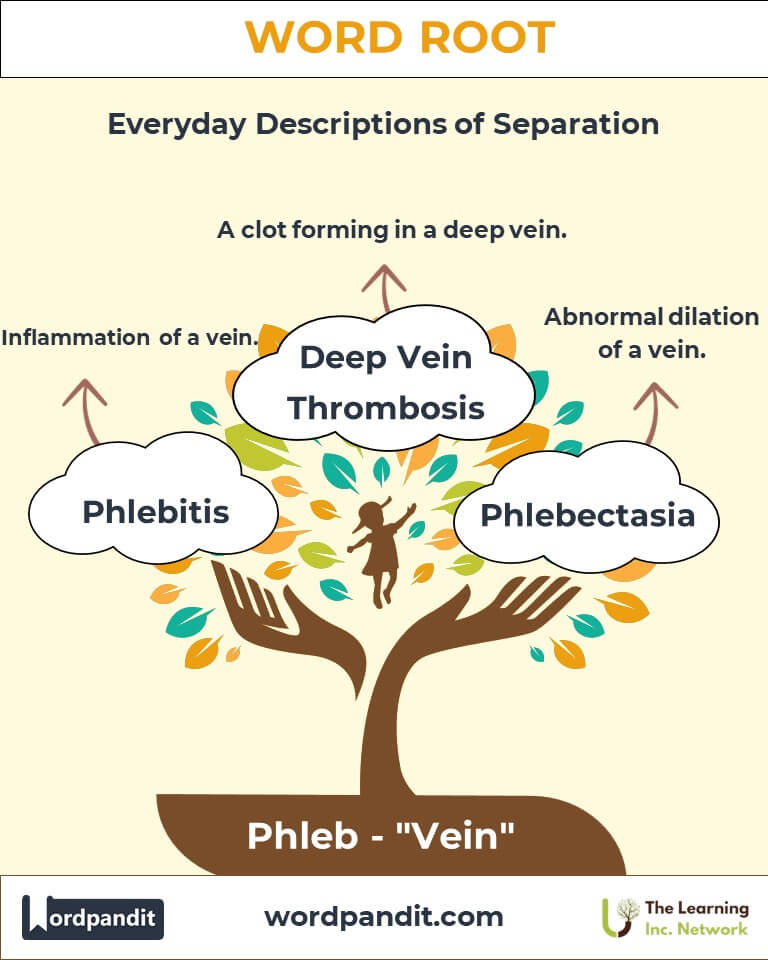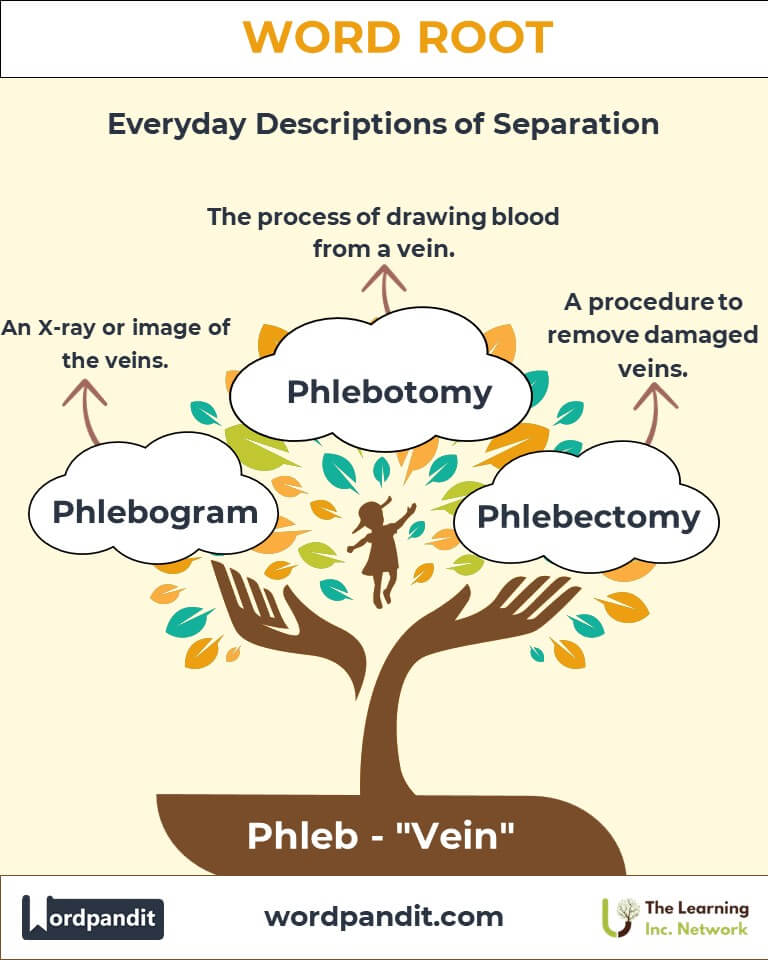Phleb: The Lifeblood of Vascular Language
Discover the meaning and importance of the root "phleb," derived from the Greek word for "vein." Found in terms like "phlebitis" and "phlebotomy," this root connects language to the essential circulatory pathways of the body, emphasizing the vitality and intricacy of our vascular systems.

Table of Contents
- Introduction: The Vitality of Phleb
- Etymology and Historical Journey
- Mnemonic: Unlocking the Power of Phleb
- Common Phleb-Related Terms
- Phleb Through Time
- Phleb in Specialized Fields
- Illustrative Story: Phleb in Action
- Cultural Significance of the Phleb Root
- The Phleb Family Tree
- FAQs About the Phleb Word Root
- Test Your Knowledge: Phleb Mastery Quiz
- Conclusion: The Living Legacy of Phleb
1. Introduction: The Vitality of Phleb
The root "phleb" (pronounced fleb) originates from the Greek word phleps, meaning "vein." It serves as the foundation for words tied to the intricate network of veins in the human body. From medical procedures like "phlebotomy" to conditions such as "phlebitis," "phleb" illuminates our understanding of vascular health, medical science, and their relevance to everyday life.

2. Etymology and Historical Journey
The root "phleb" traces back to ancient Greek. Physicians like Hippocrates used terms derived from phleps to describe veins and their functions in circulatory health. As medicine evolved, "phleb" became integral in describing diagnostic and therapeutic techniques that focus on veins.
3. Mnemonic: Unlocking the Power of Phleb
Visualize a phlebotomist drawing blood from a vein while explaining the vital role veins play in circulation.
“Phleb focuses on veins, the lifelines of the body.”
4. Common Phleb-Related Terms
- Phlebitis: Inflammation of a vein.
Example: "Phlebitis can cause swelling and pain, often requiring medical attention." - Phlebotomy: The process of drawing blood from a vein for testing or donation.
Example: "Phlebotomy is an essential skill for healthcare professionals." - Phlebogram: An X-ray or image of the veins.
Example: "A phlebogram can help diagnose vein-related issues like thrombosis." - Phlebology: The medical study of veins and their diseases.
Example: "Phlebology focuses on understanding and treating venous disorders." - Phlebectasia: Abnormal dilation of a vein.
Example: "Phlebectasia often appears in cases of varicose veins."
5. Phleb Through Time
- Phlebotomy in Ancient Greece: Used as part of early medical practices, including bloodletting, believed to balance bodily humors.
- Modern Applications: Today, phlebotomy is vital for blood tests, donations, and diagnosing vascular conditions.
6. Phleb in Specialized Fields
- Medicine: Essential for blood analysis and transfusions, particularly in phlebotomy and phlebology.
- Imaging and Diagnostics: Phlebograms are used to study vein blockages and abnormalities.
- Vascular Surgery: Procedures like phlebectomy remove damaged veins to improve health or appearance.
7. Illustrative Story: Phleb in Action
Dr. Elena, a phlebologist, encountered a patient with severe leg swelling. Using a phlebogram, she diagnosed deep vein thrombosis. With timely intervention, including minimally invasive phlebectomy, the patient recovered. This case highlighted the life-saving significance of understanding phleb-related conditions.
8. Cultural Significance of the Phleb Root
Veins symbolize vitality and interconnectedness in many cultures. They are likened to rivers that sustain life. The root "phleb" also serves as a reminder of humanity’s enduring quest to explore and understand the body's inner workings.

9. The Phleb Family Tree
- Veno- (Latin: "vein"): Examples: Venous, Venipuncture.
- Hema- (Greek: "blood"): Examples: Hematology, Hemostasis.
- Angio- (Greek: "vessel"): Examples: Angiogram, Angioplasty.

10. FAQs About the Phleb Word Root
Q: What does "phleb" mean?
A: "Phleb" means "vein" and comes from the Greek word phleps. It serves as a foundation for terms related to veins in medical contexts, emphasizing their role in circulation.
Q: What is phlebitis?
A: Phlebitis refers to the inflammation of a vein, which can cause pain, redness, and swelling. It is commonly associated with conditions like varicose veins or can occur as a result of an intravenous catheter. If left untreated, phlebitis can lead to more serious complications, such as blood clots (thrombophlebitis).
Q: What is phlebotomy, and why is it important?
A: Phlebotomy is the practice of drawing blood from a vein, either for diagnostic testing, medical treatments like therapeutic phlebotomy (e.g., for hemochromatosis), or blood donation. It is a critical skill in healthcare for obtaining accurate lab results and managing specific health conditions.
Q: What is the difference between venipuncture and phlebotomy?
A: Venipuncture is the process of puncturing a vein to access blood or administer medications. Phlebotomy is a broader term that involves drawing blood as a procedure, which includes venipuncture but also encompasses related techniques and purposes.
Q: What is a phlebogram?
A: A phlebogram is a diagnostic imaging test that uses contrast dye and X-rays to visualize veins. It helps detect abnormalities such as blood clots, blockages, or varicose veins.
Q: How is phlebology different from other vascular studies?
A: Phlebology focuses specifically on the study and treatment of vein disorders, such as varicose veins, spider veins, and venous insufficiency. Other vascular fields, like angiography or cardiology, may focus on arteries or the broader circulatory system.
11. Test Your Knowledge: Phleb Word Root Quiz
1. What does the root "phleb" refer to?
2. What is phlebitis?
3. Which medical field focuses on veins?
4. What is a phlebogram?
5. What is therapeutic phlebotomy used for?
12. Conclusion: The Living Legacy of Phleb
The root "phleb" symbolizes the intricate lifelines within our bodies, connecting language to essential vascular functions. Its applications in medicine and diagnostics reflect humanity’s progress in health sciences. By understanding "phleb," we appreciate the linguistic and scientific connections that keep us thriving.












